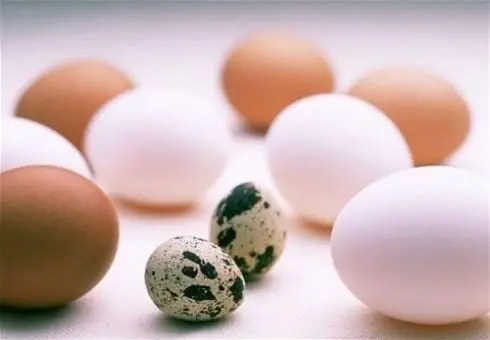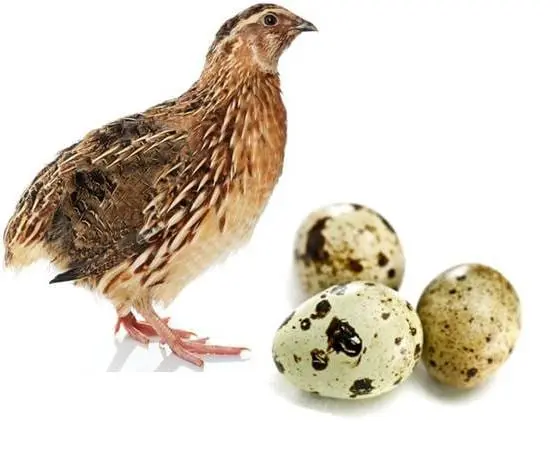Contents
- Description
- The history of quail eggs
- Composition and calorie content
- The use in medicine
- How to choose quail eggs
- Benefit
- Removal of radionuclides
- Why are quail eggs useful for men
- Consumption rate per day
- Quail eggs harm
- Comparison of chicken and quail eggs
- There is no better taste and color than quail eggs!
- Quail eggs in cooking
Description
Quail Eggs – The eggs of a small quail bird. It has a traditional round shape and resembles a large gooseberry in size. The color variegates, with brown spots of irregular shape. Egg weight about 18 grams.
The history of quail eggs
Quails are widespread in Europe, Africa, and Western Asia. Most of all quails live near plains and mountains. For wintering, they fly to the countries of Africa and South-West Asia.
The image of a quilt used the Egyptians as a hieroglyph, which meant the letter “v” or “y”. In Russia, quails were hunted and used as a songbird. Or they used male quails for a showy bird fight.
Quail eggs were popular for food. They were sources of beneficial vitamins and minerals.
Composition and calorie content
- The energy value per 100 grams is 168 kcal
- Protein 11.9 grams
- Fat 13.1 grams
- Carbohydrates 0.6 grams
The use in medicine
Quail eggs, unlike chicken eggs, have a more balanced ratio of proteins and fats, vitamins, and minerals. The amount of cholesterol, which everyone is so afraid of, is no less than chicken eggs. But it is compensated by lecithin, which does not allow cholesterol to be deposited on blood vessels’ walls.
People with high cholesterol levels should limit the consumption of Quail eggs.
How to choose quail eggs
Unlike chickens, quails have better immunity, and their eggs are less likely to be infected with anything (for example, salmonella). In contrast, eggs of thу quail bird contain a high content of lysozyme – a substance that prevents the development of bacteria and microflora in the egg (by the way, this is why these eggs, after long-term storage, do not spoil but dry out).
These eggs are beneficial and nutritious and will be useful in the diet for many buyers, so to choose fresh and high-quality eggs, you should know the following selection secrets:

When choosing quail eggs, the first thing to do is to carefully check and inspect the condition of the shell so that there is no damage (cracks, chips) on it, since, unlike the shell of chicken eggs, it is more fragile and can be easily damaged (in eggs with damaged shells are more likely to develop pathogenic bacteria).
When choosing these eggs before buying, be sure to check their expiration date, and also pay attention to the storage conditions (in the refrigerator in the store, in direct sunlight on the market). The shelf life of these eggs is on average up to 30 days at room temperature or up to 60 days in the refrigerator.
The weight of a quail egg should be on average within 10-12 grams. If the egg weighs less than 10 grams, it is no longer fresh and partially dried inside.
Externally, the surface of the quail egg should be clean (slight contamination is permissible), in which case it is an indicator that the manufacturer monitors the quality of his products (but this does not affect the quality of the egg itself and its useful properties).
Benefit
Quail eggs contain many trace elements and vitamins, and all this – with a complete absence of cholesterol in them!
Compared to a chicken egg, one gram of quail contains more vitamins: “A” – 2.5 times, “B1” – 2.8, and “B2” – 2.2 times. Vitamin D is found in these eggs in an active form; it prevents the development of rickets.
Compared with chicken eggs, the level of phosphorus and potassium is 5 times higher and 4.5 times higher in iron in these eggs. As you know, phosphorus contributes to mental development. Therefore, it is useful to include quail eggs in the diet for all students. In Japan, for example, where the useful properties of eggs of quail have been thoroughly studied for a long time, every schoolchild must receive two such eggs every day for lunch.

Quail eggs never contain salmonella. They have a solid shell and small air holes in the shell that prevent pathogenic bacteria’s entering.
Due to the high body temperature (42 degrees Celsius), quails are resistant to infectious diseases. This allows them to be kept without resorting to vaccination, which excludes the accumulation of medicinal substances in the body and eggs.
Unlike chicken eggs, quail eggs do not cause allergies in children and adults. On the contrary, the ovomucoid protein present in them can suppress allergic reactions. Therefore, on their basis, a medical preparation (ovomucoid extract) pharmacologists use to treat allergies.
The combination of all these factors allows our children to taste a delicious drink from the childhood of their fathers and mothers – “eggnog.” These eggs can and even should be eaten raw to preserve many of the nutrients you can destroy during product processing.
The use of These eggs gives excellent results in the treatment of gastritis – gastric ulcer and 12 duodenal ulcers and pancreatitis.
Removal of radionuclides
Quail eggs contribute to the elimination of radionuclides from the body. Therefore they are recommended for people who have been exposed to radiation. However, the background radiation level in large cities is also often high. Nutritionists included eggs in the diet of children exposed to radiation during the Chernobyl accident.
After a certain period of time, their general condition improved, the hemoglobin level increased, ESR returned to normal, headaches and fatigue disappeared. Biochemical analysis of blood did not reveal any deviations in its composition.

The obtained research results allow us to conclude that it is desirable to use quail eggs in the medical nutrition of weakened children and adults, primarily in ecologically unfavorable areas.
Why are quail eggs useful for men
Thanks to phosphorus, the quail egg is also a good potency stimulator. According to Bulgarian scientists, it is superior in efficiency to Viagra.
Significantly more than in chicken eggs, in quail eggs, copper, cobalt, limiting and other amino acids.
Consumption rate per day
Children are given from 2 to 6 pieces. Per day, depending on age, and adults – 4-6 eggs daily in the morning on an empty stomach. It is healthier to eat them raw with hot water. Reception should be systematic, without interruptions, for 3-4 months. Already two weeks later, their beneficial effect on the body begins to manifest.
Quail eggs harm
Many people believe that by using quail eggs instead of chicken eggs, you cannot get salmonellosis. This doesn’t seem right, they transmit salmonella, and you must follow the same safety measures with them as with other types of eggs. That is, you should eat them only after heat treatment.
Somewhere there was a misconception that these eggs do not contain cholesterol. There is even more of it in them than in chicken. True, the lecithin contained in eggs completely balances the cholesterol ratio, but you still should not get carried away with this product. Even though allergy to this type of eggs is extremely rare, at first, you should introduce them into the diet with caution.
Comparison of chicken and quail eggs
Both quail and chicken eggs are made up of protein and yolk. Outwardly, the contents do not differ, but there is a difference in the content of useful vitamins and microelements.

Quail eggs are more concentrated in terms of the content of nutrients. Their nutritional value is higher than chicken. If we compare their size, then one chicken egg corresponds to five quail. But quail eggs are superior in composition to chicken eggs:
- potassium 5 times more;
- iron – 4.5;
- B vitamins – 2.5.
In terms of the content of other microelements, quail eggs are not by a large margin in first place in comparison with chicken eggs. And they contain 5% more protein. They do not cause allergies and diathesis. For the introduction of eggs into the children’s diet, it is better to choose quail.
When compared, chicken eggs lose to smaller variety in terms of their high cholesterol content.
Fun fact. Quail actually contains more cholesterol, but in addition to it, it contains a substance that prevents the deposition of cholesterol in the vessels – it neutralizes it.
Chicken eggs contain vitamin D and fluoride, which are not found in quail eggs. They are much higher in the beneficial omega-3 and omega-6 fatty acids.
There is no better taste and color than quail eggs!
Many people compare the taste of a quail egg to a chicken one. But raw and cooked eggs have a milder taste. The white after boiling / frying has a uniform, dense texture; the yolk is dense, tender, and slightly sweet.
Quail eggs go well with almost all products from the national cuisines of different nations of the world. The product does not have a pronounced aroma and taste. Therefore it is successfully used for preparing main dishes and desserts in children’s, dietary and main menus.
Quail eggs in cooking

A small egg for great culinary feats is how the cooks of Japan, France, and Malaysia speak of this unique egg with respect. The quail egg, which is a healthier alternative to chicken and duck eggs, is widely used in a variety of tastes and looks:
- Cold and hot snacks – salads, sandwiches, toasts;
- Sauces for meat, fish and vegetable dishes;
- First courses – traditional and mashed soups;
- Absolutely all baked goods, in the recipe of which chicken eggs are indicated (the ratio of 1 chicken egg to 4 quail eggs);
- Dairy desserts;
- Drinks – from the traditional egg cocktail to the vitamin “elixir” with wine and honey;
- Omelettes and poached;
- Boiled eggs pickled in complex brine.
The shell of quail eggs does not crack during cooking, so they can be safely dipped immediately into boiling water.









